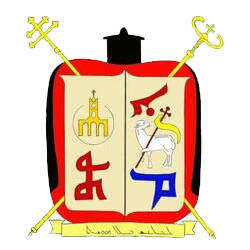



Syriac Catholic Cathedral of Saint Paul, the Seat of the Syriac Catholic Church in Damascus, Syria |
|
| Type | Antiochian |
|---|---|
| Classification | Eastern Catholic |
| Orientation | Syriac |
| Scripture | Peshitta |
| Polity | Episcopal |
| Pope | Francis |
| Patriarch | Ignatius Joseph III Yonan |
| Region | Near-East; Lebanon, Syria, Iraq, Turkey with communities in United States, Canada, France, Sweden, Venezuela, Brazil, Argentina and Australia |
| Language | Syriac, Aramaic |
| Liturgy | West Syriac Rite |
| Headquarters | Beirut, Lebanon |
| Founder | Traces ultimate origins to Apostles St. Paul and St. Peter Through Patriarchs Ignatius Andrew Akijan (1662) and Ignatius Michael III Jarweh (1782) |
| Branched from | Church of Antioch |
| Members | 153,415 (2018) |
The Syriac Catholic Church (Classical Syriac: ܥܕܬܐ ܣܘܪܝܝܬܐ ܩܬܘܠܝܩܝܬܐ, romanized: ʿĪṯo Suryayṯo Qaṯolīqayṯo, Arabic: الكنيسة السريانية الكاثوليكية), also known as Syriac Catholic Patriarchate of Antioch, is an Eastern Catholic Christian church in the Levant that uses the West Syriac Rite liturgy and has many practices and rites in common with the Syriac Orthodox Church. Being one of the twenty-three Eastern Catholic Churches, the Syriac Catholic Church has full autonomy and is a self-governed sui iuris church while it is in full communion with the Holy See of Rome.
The Syriac Catholic Church traces its history to the earliest days of Christianity. After the Chalcedonian Schism the Antiochian Church became part of Oriental Orthodoxy, and was known as the Syriac Orthodox Church, while a new Antiochian patriarchate was established to fill its place by the churches which accepted the Council of Chalcedon. The Syriac Orthodox Church came into full communion with the Holy See and the modern Syriac Orthodox Church is a result of those that did not want to join the Catholic Church. Therefore, the Syriac Catholic Church is a continuation of the original Church of Antioch.
The church is headed by Mor Ignatius Joseph III Younan, who has been the patriarch since 2009. Its patriarch of Antioch has the title of Patriarch of Antioch and all the East of the Syriacs and resides in Beirut, Lebanon.
Jesuit and Capuchin missionaries began to work among the Syriac Orthodox in Aleppo in 1626. So many of them were received into communion with Rome in 1662, when the patriarchate had fallen vacant, and the Catholic party was able to elect one of its own, Andrew Akijan, as patriarch of the Syriac Church. This provoked a split in the community, and after Akijan's death in 1677 two opposing patriarchs were elected, one being the uncle of the other, representing the two parties (one pro-Catholic, the other anti-Catholic). But when the Catholic patriarch died in 1702, this very brief line of Catholic patriarchs upon the Syriac Church's See of Antioch died out with him.
Later, in 1782, the Syriac Orthodox Holy Synod elected Metropolitan Michael Jarweh of Aleppo as patriarch. Shortly after he was enthroned, he declared himself Catholic and in unity with the Pope of Rome. Since Jarweh, there has been an unbroken succession of Syriac Catholic Patriarchs.
Go to website